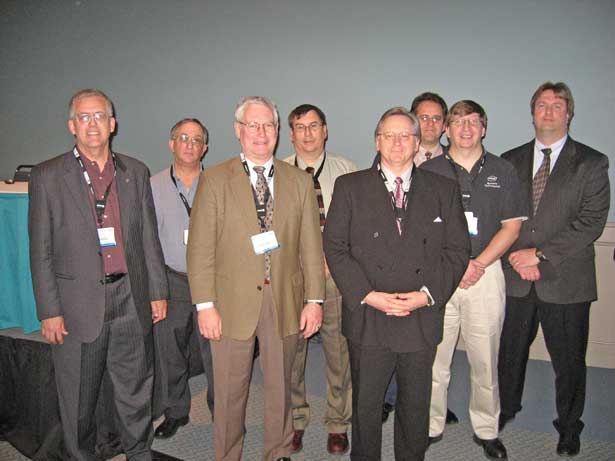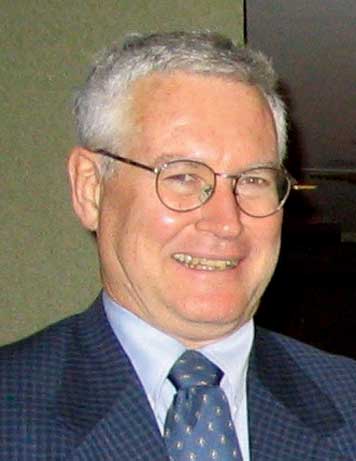Introduction
The EMC Society took a positive step towards reaching out to other
IEEE Societies by scheduling and presenting a day-long Workshop
on “EMC Aspects of Wireless Technology and Cell Phone Packaging.”
This workshop was presented Monday, January 8th, 2007 at the 2007
IEEE Radio and Wireless Symposium held at the Long Beach Convention
Center in Long Beach, California. This was only the second year
this particular Symposium was held and it was selected for the
outreach attempt because of its potential fit with EMC and because
it was sponsored by MTT-S and co-sponsored by the Communications
Society (ComSoc) and the Antennas and Propagation Society (APS).
Organizers
The Organizers of the workshop included Andy Drozd, current President
of the EMC Society; Karl Varian, immediate Past-President of the
Microwave Theory and Techniques Society, and Dan Hoolihan, former
President of the EMC Society (1998-1999).
 |
| Participants in the Wireless Workshop
included (from left) Karl Varian, Raytheon, Organizer, Kevin
Slattery, Intel, Speaker, Dan Hoolihan, Hoolihan EMC Consulting,
Organizer and Speaker, Dave Case, Cisco, Speaker, Andy Drozd,
ANDRO Computational Solutions, Organizer and Speaker, Mike
Violette, Washington Labs and ATCB, Speaker, Harry Skinner,
Intel, Speaker and Michael Foegelle, ETS-Lindgren, Speaker. |
Speakers
Presentations were given by Harry Skinner of Intel Corporation,
Kevin Slattery of Intel Corporation, Michael Foegelle of ETS-Lindgren,
Dave Case of Cisco Systems Corporation, Mike Violette of Washington
Labs and American TCB Corporation, Andy Drozd of ANDRO Computational
Solutions LLC, and Dan Hoolihan of Hoolihan EMC Consulting.
Harry Skinner’s first talk was on “Radio Frequency
Interference.” His radios are wireless radios in laptop
computers so it becomes an “intra-system interference”
issue between the electromagnetic interference from the electronics
of the laptop and the sensitivity requirements of the wireless
radios in the laptop. In some frequency bands, as much as 90 dB
of isolation is required to prevent this “intra-system”
interference. In general, interference requirements to prevent
disrupting the radio service may be 40 dB lower than those required
to meet “inter-system” regulatory electromagnetic
interference requirements!
Kevin Slattery continued the workshop by discussing the topic
of “Reducing Interference in Notebook Wireless Systems.”
His talk highlighted a series of measurements (based on work done
by his co-workers Xiaopeng Dong and Jin Shi) and investigations
into antenna placement on laptop lids and simulations of lid resonances.
The measurements used both magnetic field scanning and electric
field scanning to characterize the source-noise in the laptop.
It was found that by placing an antenna several centimeters away
from the resonant structures in the laptop that the interference
levels could be lowered by as much as 20 dB. Antenna placement
will differ from computer to computer and experimentation is required
to find the best position. Recommendations for antenna placement
were made at the conclusion of the talk.
The third presenter of the workshop was Michael Foegelle who discussed
the topic of “Coexistence of Wireless Technologies in Converged
Devices.” In his talk, he defines wireless convergence to
be “the growing trend to have multiple radios in one wireless
device.” This can be cell phones with Bluetooth, cellular
devices with Wi-Fi and Bluetooth, and similar personal electronic
devices with multiple wireless-radio capabilities. Michael also
defines wireless coexistence to be “the general topic of
multiple wireless technologies working harmoniously (i.e., without
interference) in the same environment.” Many tests can be
performed on the radios in wireless devices by using conducted
measurements; however, in the end, determination of the actual
performance requires radiated testing. Interference in converged
devices can occur in the communication frequency band or in the
receiver circuitry. Standards are beginning to be developed and
could affect device performance. As the number of radios in any
one device proliferate, the engineering challenges to interoperability
will increase significantly.
The fourth topic of the workshop was “Evaluating the Impact
of RFI on WLAN/WWAN Performance” and was presented by Harry
Skinner and based on work done by Harry and his co-worker Anh
Dang. WLAN is Wireless Local Area Network and refers to technologies
that are unlicensed. WWAN is Wireless Wide Area Network and refers
to technologies that are licensed radios. A comparison of throughput
performance was made by measuring a wireless card only and then
measuring a wireless card plus a PCIe video graphics card. The
comparison showed a degradation of 2 to 3 dB for WLAN due to the
6th harmonic of the PCIe memory clock. It was also found that
the Total Isotropic Sensitivity of a WWAN device can be negatively
affected by clock harmonics and this could block the wireless
device from being accepted by the wireless carriers.
Kevin Slattery gave his second talk of the workshop and it addressed
the topic “An Analysis of Digital Display Frame Symbols
and Their RFI Potentials.” The objective of the talk was
to develop a method for determining EMI/RFI impact in advance
of system measurement. The purpose of this would be to select
a set of display symbols to minimize their EMI/RFI impact by coordinating
their bit structure. It was found that there could be as much
as 30 dB difference between the interference potential of clock
harmonics, display symbols, and pseudo-random bit streams (PRBS).
By realizing that different symbols produce different spectral
peak distributions, a Fourier series components of signal symbols
can be ordered to reduce the EMI impact. Measurement results utilizing
this theory matched the theoretical results closely. It was also
found that differential signals can reduce the EMI impact, but
only if the intra-pair skew is minimized.
The first speaker of the afternoon was Dan Hoolihan who spoke
on “EMC and Telecommunications: A Regulatory Review.”
This topic was introduced by drawing comparisons between the similarities
and differences of EMC testing and Telecom testing. A brief history
of the Federal Communications Commission led into a description
of Telecom Certification Bodies in the USA. This was followed
by a brief review of Canadian, European, South American, and Asian
telecom regulations. Finally, the basic measurement parameters
for general FCC telecom testing were analyzed including RF Power
Output, Modulation Characteristics, Occupied Band Width, Antenna
Terminal Spurious Emissions, Radiated Spurious Emissions, and
Frequency Stability with temperature and voltage.
Dave Case followed with a presentation on “A Look at the
4.9 GHz Public Safety Band.”
This topic has received expanded attention since “9/11”
and “post-Katrina” difficulties with public safety
officials communicating with one another in emergencies. The US
government set aside a frequency band for broadband wireless for
Public Safety; it selected the 4940-4990 MHz frequency range on
a licensed basis. Two emission masks to mitigate interference
were specified by the FCC in order to allow present-day IEEE 802.11
technology and still cover higher-power systems. Canada has adopted
similar regulations and other countries around the world are looking
at the 4.9 GHz band for Public Safety needs.
The next presentation was given by Mike Violette and was entitled
“Twists and Turns on the Road to Wireless Compliance.”
In this talk, Mike covered the evolution of EMC testing from the
1980s with its emphasis on FCC compliance of Personal Computers,
the 1990s with the European influence on commercial immunity testing,
and the 2000s with wireless certification and integrated EMC/wireless
testing. This has resulted in the EMC test lab seeing an increased
complexity in the tests it runs leading to the need for an expanded
test equipment inventory. Wireless technologies that are commonly
measured include WiFi, Broadband over Power Line, RFID, Ultra
Wide Band, frequency-agile transmitters, and WiMax. Challenges
to testing for wireless include access to common procedures, setup
and operation of the customer’s equipment, failure modes,
and disagreement between different parts of the FCC Rules.
The final presentation of the day was given by Andy Drozd and
it was titled “Transmission Hyperspace: An Approach for
Efficient and Interference-Free Spectrum Management for Diverse
Radio Systems and Cellular Communications Equipment.” In
his presentation, Andy discussed spectrum policy reform, emerging
technologies (such as Software Designed Radio), jointly optimized
transmission hyperspace, and computer simulation of spectrum management
domains. Current spectrum management policy is based on narrowband
analog signals; and, it has very little meaning for more modern
wideband digital systems. Both the FCC, with its spectrum policy
task force, and DARPA, with its XG program, have started to investigate
a more efficient use of the electromagnetic spectrum. The IEEE
1900.x projects are also looking at standards for the next generation
of radio and advanced spectrum management. Andy defined a Transmission
Hyperspace to be “an electromagnetically occupied volume
bounded in all dimensions including time, space, frequency diversity,
code/modulation/waveform diversity, polarization, power budgeting,
and smart antenna directivity.” Using a “Challenge
Problem” simulation concept, it was shown that a better
than 20 times performance improvement of the spectrum transmission
could be achieved.
Conclusion
The workshop presented at the MTT-S 2007 IEEE Radio and Wireless
Symposium was similar to a workshop with a similar title given
at the 2006 IEEE International Symposium on EMC in Portland, Oregon.
The workshop presents important ideas on challenges of EMC and
wireless devices as their size shrinks and their “radio”
capabilities expand. It is hoped to give a similar workshop at
the 2007 IEEE International Symposium on EMC in Hawaii in July
of 2007. EMC
|
|
|
 EMC
Society Outreach to Microwave Theory and Techniques Society (MTT-S)
EMC
Society Outreach to Microwave Theory and Techniques Society (MTT-S)